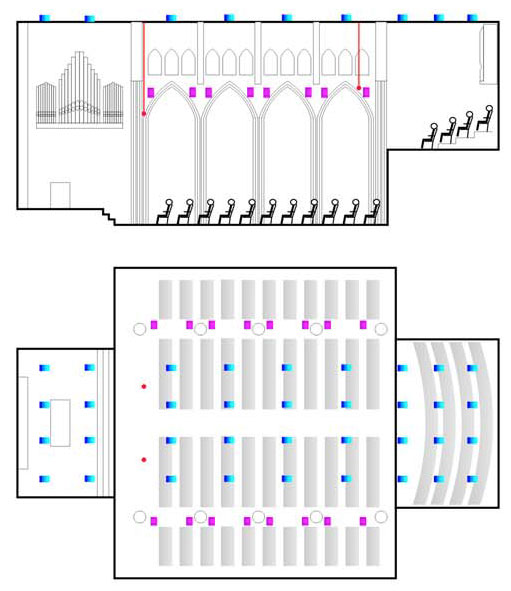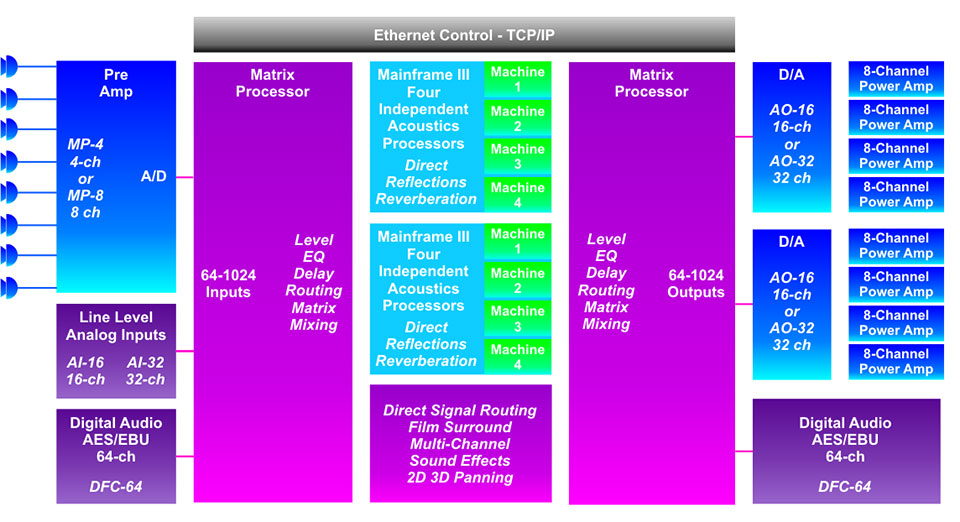Technology
Generation 3
E-coustic Systems Electronic Architecture™ is the product of over 30 years research in the fields of digital audio, neuroscience, and acoustics - refined by more than 20 + years of successful installations in a wide variety of venues and applications. E-coustic Systems incorporates patented signal processing techniques that overcome the fundamental physics problem of using microphones and loudspeakers together – acoustic feedback. This, combined with our third generation acoustics processing, delivers astonishing acoustic realism that was heretofore unattainable. Generation 3 hardware provides a range of systems that are optimally scaled for different venue sizes and performance requirements.
E-coustic Systems is by far the most cost effective acoustic enhancement product available. Our new hardware platforms have been scaled for venue size and performance requirements. This represents a breakthrough in cost without compromise to flexibility or reliability.
E-Performance
With up to 512 audio channels, E-Performance can accommodate a wide variety of venue sizes, applications, and demanding audio requirements such as multi-channel film and media surround sound, 2D and 3D sound immersion.
E-Architecture
E-Performance
Microphones pick up the direct and reflected sound generated by the sound source. E-coustic Systems patented processing uses independent time variant channels that de-correlate both the individual loudspeakers and the microphones. The result is an astonishing increase in system stability. The basic system depicted provides a 12dB-18dB increase in gain before feedback. This provides unprecedented simplicity and flexibility in system implementation. Microphone counts are dramatically reduced when compared to other methods. Additionally, microphone and loudspeaker “channels” and counts are completely independent. This allows the optimum number of microphones and loudspeakers to be used when and where they are required.
E-coustic Systems signal processing enables loudspeakers and microphones to be placed in close proximity to one another without the consequences of coloration or system instability. Our system architecture is not reliant on the acoustic properties of the room. It is the only system that breaks the fixed relationship that exists in architectural acoustics between reverberation time and reverberation level - allowing independent adjustment of both throughout the venue. This enables our systems to be successfully integrated in facilities like rehearsal rooms. recording studios. and sound stages where acoustic treatments are used intentionally to create a neutral condition. E-coustic Systems unique processing also enables systems to be successfully integrated into outdoor performing arts facilities, providing the warmth and envelopment that significantly improves the listening experience.
E-Performance Basic System
E-Performance Signal Flow
E-Performance Integration: Example 1

Acoustics Processors (Machines) provide independent adjustment of direct, reflected, and reverberant energy. Machines can be assigned to specific portions of a venue, or combined as required to provide optimum listening conditions. In this example, Machines are assigned as follows:


E-Performance Integration: Houses of Worship

Acoustics Processors (Machines) provide independent adjustment of direct, reflected, and reverberant energy. Machines can be assigned to specific portions of a venue, or combined as required to provide optimum listening conditions.

Signals from Machine 1 and Machine 2 have independent delay, EQ, and level adjustment and are matrix mixed to each ceiling loudspeaker.
Signals from Machine 3 and Machine 4 have independent delay, EQ, and level adjustment.
E-Architecture
E-Architecture expands the capacity of the E-Performance system to meet the demands of the largest and most complex venues and applications. E-Architecture accommodates multiple MainFrame III acoustics processors, as well as independent analog inputs for surround sound and effects channels It can also accommodate multi-channel digital inputs from digital consoles, or outputs from multi-channel editing systems like Pro Tools.
As with E-Performance, microphones pick up the direct and reflected sound generated by the sound source. E-Coustic Systems patented processing uses independent time variant channels that de-correlate both the individual loudspeakers and the microphones. The result is an astonishing increase in system stability. The basic system depicted provides a 12dB-18dB increase in gain before feedback. This provides unprecedented simplicity and flexibility in system implementation. Microphone counts are dramatically reduced when compared to other methods. Additionally, microphone and loudspeaker “channels” and counts are completely independent. This allows the optimum number of microphones and loudspeakers to be used when and where they are required.
E-Coustic Systems signal processing enables loudspeakers and microphones to be placed in close proximity to one another without the consequences of coloration or system instability. Our system architecture is not reliant on the acoustic properties of the room. It is the only system that breaks the fixed relationship that exists in architectural acoustics between reverberation time and reverberation level - allowing independent adjustment of both throughout the venue. This enables our systems to be successfully integrated in facilities like rehearsal rooms, recording studios, and sound stages where acoustic treatments are used intentionally to create a neutral condition. E-Coustic Systems unique processing also enables systems to be successfully integrated into outdoor performing arts facilities, providing the warmth and envelopment that significantly improves the listening experience.
E-Architecture

E-Architecture Signal Flow


Acoustics Processors (Machines) provide independent adjustment of direct, reflected, and reverberant energy. Machines can be assigned to specific portions of a venue, or combined as required to provide optimum listening conditions. In this example, Machines are assigned as follows:
VIRTUAL STAGE SHELL
Choir microphone on stage left are sent to Machine 1, which provides energy to stage right. Choir microphones on stage right are sent to Machine 2, which provides reflected energy to stage left. A mix of choir microphones and platform orchestra microphones are sent to Machine 3, which provides optimum reverberation for the choir and orchestra. A separate mix of these microphones is sent to Machine 4, which provides direct-reflected energy to the large format loudspeakers that make up the virtual forestage reflector.
WORSHIP SPACE
As separate mix of signals from the choir microphones and the orchestra platform are sent to Machine 5 that provides independent adjustment of direct and reflected energy from overhead speakers throughout the worship space. A similar mix of signals is sent to Machine 6 that provides independent adjustment late reflected energy and reverberation.
CONGREGATION
Signals microphones located over the congregation are sent to Machine 7 and Machine 8, which provide independent adjustment of early and late energy from the congregation that is distributed throughout the volume.
